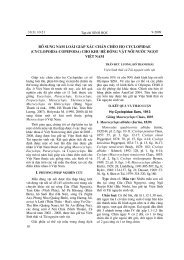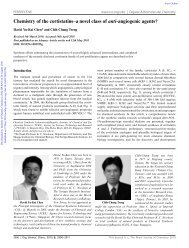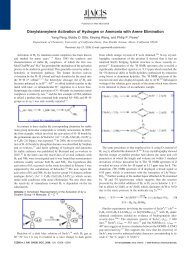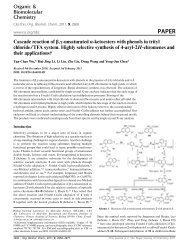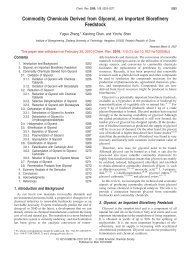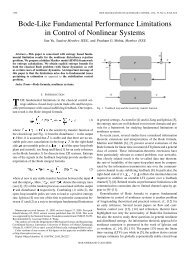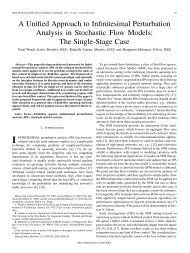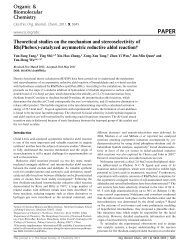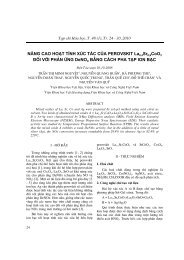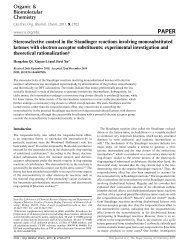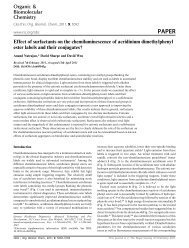uril and cucurbit[8]uril
uril and cucurbit[8]uril
uril and cucurbit[8]uril
Create successful ePaper yourself
Turn your PDF publications into a flip-book with our unique Google optimized e-Paper software.
Fig. 3 Relative cell viability of CHO-K1 cells in dependence on CB[8]<br />
concentration (0–20 mM) after 48 h incubation time determined using the<br />
MTT assay by monitoring formazan absorbance at 570 nm. Mean values<br />
<strong>and</strong> st<strong>and</strong>ard deviations were obtained from five independent experimental<br />
determinations.<br />
investigated concentration of 20 mM after 48 h (the solubility limit<br />
in the employed cell culture medium), the relative cell viability<br />
dropped marginally to 86 ± 7%. While this effect is too small to<br />
rigorously substantiate an emerging cytotoxic effect, it prevented<br />
in any case an accurate determination of the IC 50 value of CB[8].<br />
Next, we examined the cytotoxicity effect of CB[7] within 3 h of<br />
administration (Fig. 2B). This time scale is particularly relevant for<br />
fluorescence microscopic imaging applications of cells <strong>and</strong> tissues,<br />
where st<strong>and</strong>ard incubation times range from minutes to hours. 53<br />
Recall, in this context, that CB[7] has been suggested as an additive<br />
to increase the brightness <strong>and</strong> photostability of fluorescent dyes<br />
used for fluorescence staining, 26–30 a prospective application which<br />
is greatly facilitated by the absence of cytotoxic effects as well as<br />
other detrimental effects on cellular integrity. Indeed, at shorter<br />
incubation times even a higher CB[7] concentration of 1 mM<br />
was found to be tolerable. For comparison, administration of<br />
CB[8] caused no reduction in cell viability over the shorter (3 h)<br />
incubation time.<br />
We further examined the effect of CB[7] on the metabolic<br />
activity of living cells when working near the IC 50 concentration<br />
at short incubation times. For this purpose, the mitochondria<br />
of CHO-K1 cells were stained with MitoTracker Red CMXRos,<br />
a membrane potential-dependent probe, which can selectively<br />
distinguish metabolically active mitochondria. 54,55 The integrity of<br />
mitochondria was studied by fluorescence microscopy (Fig. 4).<br />
To exclude possible artifacts due to interaction of the probe<br />
with CB[7], e.g., due to inclusion complex formation, 26–30 we<br />
conducted the experiments by varying the sequence of addition,<br />
i.e. MitoTracker incubations followed by CB[7] <strong>and</strong> vice versa<br />
(Fig. 4B <strong>and</strong> C, respectively). Mitochondrial activity was found to<br />
be retained under all experimental conditions since they preserved<br />
the characteristic elongated spaghetti-like structure through the<br />
cytosol as seen in the control sample containing no CB[7]<br />
(Fig. 4A). Overall inspection of the micrographs showed that the<br />
cellular architecture <strong>and</strong> integrity was preserved in the presence<br />
of CB[7], e.g., no signs characteristic for necrosis or apoptosis like<br />
rupture or plasma membrane blebbing were observed. To sum up,<br />
no cytotoxic effects were observed at a concentration of 0.5 mM<br />
CB[7] applied in complete culture medium.<br />
The results of the cytotoxicity study with cultured mammalian<br />
cells clearly indicated that CB[7] exhibits almost no cytotoxicity<br />
when administered over 2 days at concentrations below 0.5 mM<br />
(Fig. 2A), with concentrations of 1 mM being tolerable for<br />
shorter time periods in the range of few hours (Fig. 2B). Higher<br />
concentrations lead to decreased cell proliferation. The live-cell<br />
imaging studies further revealed no signs of cytotoxicity when<br />
working near the IC 50 value (0.53 mM). Most importantly, after<br />
treatment with subtoxic CB[7] amounts, the metabolic activity<br />
of the cells was preserved, indicated by the intact structure of<br />
mitochondria <strong>and</strong> by their ability to maintain an intact membrane<br />
potential across the inner mitochondrial membrane, which is a<br />
prerequisite in order to accumulate the MitoTracker probe within<br />
the mitochondrial matrix (Fig. 4). CB[8] showed no significant<br />
Fig. 4 Micrographs depicting staining of the mitochondria with MitoTracker Red CMXRos in metabolically active CHO-K1 cells: (A) MitoTracker<br />
applied without CB[7] as a control; (B) incubation with MitoTracker (45 min), then 0.5 mM CB[7] (30 min); (C) incubation with 0.5 mM CB[7] (30 min),<br />
then MitoTracker (45 min). Every micrograph includes a black-<strong>and</strong>-white magnified image of the fluorescence signal of individual cells (upper panels,<br />
10 mm scale bar), as well as fluorescence <strong>and</strong> phase contrast images as overviews (lower panels, 50 mm scale bar). White arrows indicate the elongated<br />
spaghetti-like structures of the mitochondria.<br />
This journal is © The Royal Society of Chemistry 2010 Org. Biomol. Chem., 2010, 8, 2037–2042 | 2039


![uril and cucurbit[8]uril](https://img.yumpu.com/5692724/4/500x640/uril-and-cucurbit8uril.jpg)
